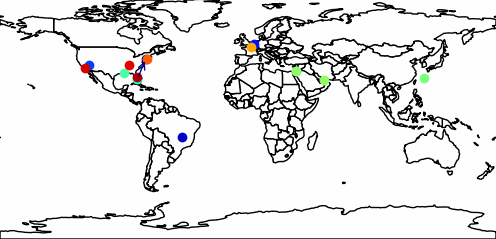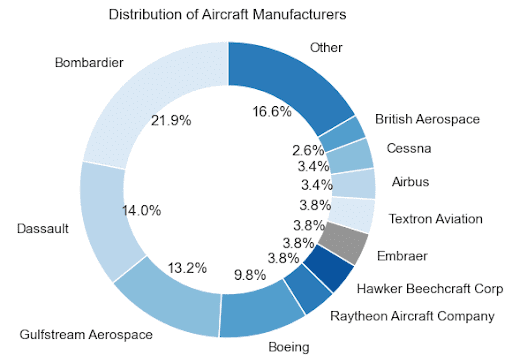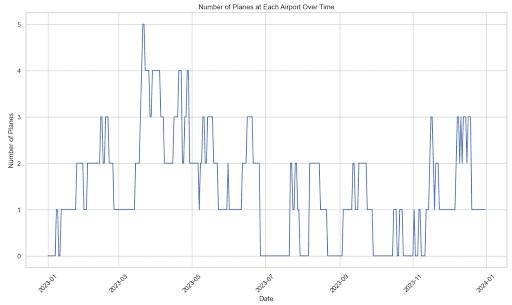
Introduction
During an Open Source Intelligence (OSINT) investigation, there are occasions when tracking an aircraft associated with a particular individual or corporation becomes necessary. This tracking is made possible through flight data provided by platforms like RadarBox or FlightRadar. These services access data from ADS-B nodes (ground stations monitoring aircraft radar signals) and display the trajectories and routes of various aircraft. Nonetheless, it’s not uncommon to find that data pertaining to specific planes is missing from these platforms. Often, this omission stems from legal demands made by High-Net-Worth-Individuals (HNWIs) prioritising their privacy, although it’s also a common practice for military or government flight information to be excluded from these datasets.
This article analyses 275 aircraft that fit this criteria, featuring in RadarBox’s blocked list. Utilising a dataset derived from a Google dork query, this analysis focuses on the 2023 flight paths of these aircraft, while also exploring ownership, co-location and other interesting trends.
Background
Aircraft tracking has been made possible by the advent of ADS-B which has been increasingly adopted in different jurisdictions since since the late 2000’s. This system, which relies on aircraft broadcasting their location, speed, and other data, has been a game-changer for both aviation professionals and enthusiasts. Websites like RadarBox and FlightTracker have capitalised on this technology to provide real-time tracking of aircraft around the globe. As mentioned, the data available on these platforms can sometimes be incomplete for various reasons, including legal aggression, especially from individuals or entities keen on keeping their travel details confidential.
ADSbexchange stands out as a unique player in the flight data market, and is the resource used to complete this study. It is a network of hobbyists and enthusiasts who share a passion for aircraft tracking. This community-driven approach has fostered a more resilient ethos and the platform is less prone to censorship or removal requests, making it a great OSINT resource.
The significance of flight data, both its accessibility and the efforts made to conceal it, is underscored in the financial trading sector. Traders have been known to leverage such information to forecast mergers and acquisitions. Analysis of these flights and their frequencies, especially to locations known for hosting corporate negotiations or legal consultations, can afford early insights into possible market-shifting events.
Google Dork
The Google Dork query site:radarbox.com “This aircraft is present on our blocked aircraft list” was used as a starting point for the investigation. A Google Dork is a search technique that employs specific search strings to unearth information which might otherwise not rank highly in search engine results. In this case, the query is tailored to search within the domain of RadarBox for a specific phrase: “This aircraft is present on our blocked aircraft list”.
What this query does is pinpoint the exact pages on RadarBox where aircraft are listed as ‘blocked’. These blocked listings are significant because they often relate to aircraft where flight details are deliberately concealed. These aircraft web pages were used to compile a dataset with the hope of identifying interesting patterns, such as frequent travel to certain destinations or co-location with other blocked aircraft.
Initial Analysis
As you might expect, patterns emerging from initial analysis are indicative of typical private aircraft use, particularly when considering the types of aircraft and their respective destinations. These patterns offer a glimpse into the travel habits and preferences of HNWIs.
The dataset reveals a diverse range of aircraft manufacturers. However, certain brands stand out, indicating a preference for specific manufacturers known for their prestige.
Analysis of plane models within the dataset shows that high-end models, such as the Bombardier Global series, feature prominently. These models are renowned for their range and comfort aligning with the travel needs and expectations of HNWIs.
The countries of registration for these aircraft also tell a story. Certain jurisdictions may be favoured due to favourable tax regimes or privacy laws, which are factors often considered by affluent individuals and corporations.
A significant portion of these aircraft are held by LLCs, LTDs, and Inc entities. This trend in ownership structure is indicative of attempts to manage privacy, liability, and sometimes, to leverage financial benefits. The complexity of these structures can often mirror the intricate financial and legal arrangements typical of HNWI affairs.
Co-location Analysis
Below is a co-location matrix showing how often different pairs of aircraft were co-located throughout 2023.
The matrix’s substantial co-location primarily stems from the frequent use of major airports like London, Dubai, and Washington, which is evident from the abundance of green and yellow on the chart. This kind of analysis can be valuable for identifying patterns in the movements of HNWIs, as well as their potential business and personal connections, should you try and recreate something similar for your own investigation.
To identify airports exhibiting anomalous spikes in activity, I analysed variations in yearly traffic patterns. This approach highlighted Hong Kong International Airport, which displayed a notable surge in activity around March 2023, indicating a period of unusual busyness.
During the unusual activity period at Hong Kong, the aircaft were exclusively leased or hired private jets, as opposed to private planes owned by HNWIs. To maintain privacy and avoid unintentionally doxxing, details about the real/beneficial owners or lessees of the aircraft have not been disclosed. However, those familiar with OSINT will recognise the potential value of exploring corporate records and social media intelligence to ascertain the identities of individuals travelling on aircraft within a given timeframe. While a detailed discussion of these methods is beyond the scope of this article, numerous online resources are available for those interested in learning more.
The spike in activity at Hong Kong airport does coincide with Hong Kong Art Basel, a prestigious event in the world of contemporary art. Art Basel, a series of international art fairs held annually in Hong Kong, Basel, and Miami, showcases a wide array of modern and contemporary artworks from established and emerging artists, presented by leading galleries. This event has become a magnet for billionaires and art connoisseurs due to its reputation as a hub for significant art transactions and networking opportunities. The fair is not only a platform for buying and selling high-value artworks but also serves as a cultural and social gathering, attracting a global audience that includes collectors, museum directors, curators, and art enthusiasts. As a result, it’s a key event on the social calendars of the wealthy, often leading to an increase in private jet traffic to the host cities during these fairs. While correlation is not causation, there is a realistic possibility that the spike in HNWI air traffic is related.
So What?
The act of removing or blocking flight data from public tracking sites is a double-edged sword. On one hand, it serves the legitimate interest of providing privacy for HNWIs and corporations. However, this very act of concealment can sometimes draw more attention, paradoxically highlighting the individuals or entities as subjects of interest.
The tracking and public dissemination of flight data also bring to the forefront concerns about the security and privacy of individuals. There is a fine line between public interest and invasion of privacy, and the potential for misuse of this data for malicious purposes cannot be overlooked. Legal approaches to the removal of data are effective and worthwhile but when they can be circumvented by aggregation elsewhere HNWIs should consider engaging OSINT experts to supplement legal strategies.
Feel free to reach out if you have any questions, I can be found on Twitter, Reddit and LinkedIn.
Please also check out my other OSINT project ReversePP, a planning application aggregator.





